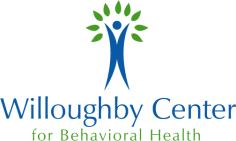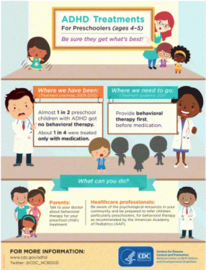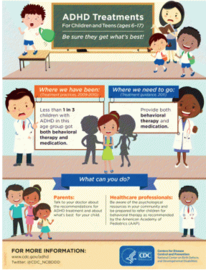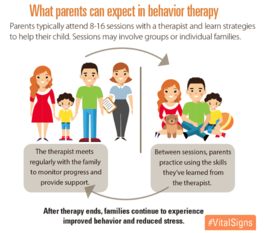Attention Deficit Hyperactivity Disorder (ADHD)
Attention-deficit/hyperactivity disorder (ADHD) is a brain disorder marked by an ongoing pattern of inattention and/or hyperactivity-impulsivity that interferes with functioning or development.
- Inattention means a person wanders off task, lacks persistence, has difficulty sustaining focus, and is disorganized; and these problems are not due to defiance or lack of comprehension.
- Hyperactivity means a person seems to move about constantly, including in situations in which it is not appropriate; or excessively fidgets, taps, or talks. In adults, it may be extreme restlessness or wearing others out with constant activity.
- Impulsivity means a person makes hasty actions that occur in the moment without first thinking about them and that may have high potential for harm; or a desire for immediate rewards or inability to delay gratification. An impulsive person may be socially intrusive and excessively interrupt others or make important decisions without considering the long-term consequences.
Signs and Symptoms
Inattention and hyperactivity/impulsivity are the key behaviors of ADHD. Some people with ADHD only have problems with one of the behaviors, while others have both inattention and hyperactivity-impulsivity.Most children have the combined type of ADHD.
In preschool, the most common ADHD symptom is hyperactivity.
It is normal to have some inattention, unfocused motor activity and impulsivity, but for people with ADHD, these behaviors:
- are more severe
- occur more often
- interfere with or reduce the quality of how they functions socially, at school, or in a job
Inattention
People with symptoms of inattention may often:
- Overlook or miss details, make careless mistakes in schoolwork, at work, or during other activities
- Have problems sustaining attention in tasks or play, including conversations, lectures, or lengthy reading
- Not seem to listen when spoken to directly
- Not follow through on instructions and fail to finish schoolwork, chores, or duties in the workplace or start tasks but quickly lose focus and get easily sidetracked
- Have problems organizing tasks and activities, such as what to do in sequence, keeping materials and belongings in order, having messy work and poor time management, and failing to meet deadlines
- Avoid or dislike tasks that require sustained mental effort, such as schoolwork or homework, or for teens and older adults, preparing reports, completing forms or reviewing lengthy papers
- Lose things necessary for tasks or activities, such as school supplies, pencils, books, tools, wallets, keys, paperwork, eyeglasses, and cell phones
- Be easily distracted by unrelated thoughts or stimuli
- Be forgetful in daily activities, such as chores, errands, returning calls, and keeping appointments
Hyperactivity-Impulsivity
People with symptoms of hyperactivity-impulsivity may often:
- Fidget and squirm in their seats
- Leave their seats in situations when staying seated is expected, such as in the classroom or in the office
- Run or dash around or climb in situations where it is inappropriate or, in teens and adults, often feel restless
- Be unable to play or engage in hobbies quietly
- Be constantly in motion or “on the go,” or act as if “driven by a motor”
- Talk nonstop
- Blurt out an answer before a question has been completed, finish other people’s sentences, or speak without waiting for a turn in conversation
- Have trouble waiting his or her turn
- Interrupt or intrude on others, for example in conversations, games, or activities
Diagnosis of ADHD requires a comprehensive evaluation by a licensed clinician, such as a pediatrician, psychologist, or psychiatrist with expertise in ADHD. For a person to receive a diagnosis of ADHD, the symptoms of inattention and/or hyperactivity-impulsivity must be chronic or long-lasting, impair the person’s functioning, and cause the person to fall behind normal development for his or her age. The doctor will also ensure that any ADHD symptoms are not due to another medical or psychiatric condition. Most children with ADHD receive a diagnosis during the elementary school years. For an adolescent or adult to receive a diagnosis of ADHD, the symptoms need to have been present prior to age 12.
ADHD symptoms can appear as early as between the ages of 3 and 6 and can continue through adolescence and adulthood. Symptoms of ADHD can be mistaken for emotional or disciplinary problems or missed entirely in quiet, well-behaved children, leading to a delay in diagnosis. Adults with undiagnosed ADHD may have a history of poor academic performance, problems at work, or difficult or failed relationships.
ADHD symptoms can change over time as a person ages. In young children with ADHD, hyperactivity-impulsivity is the most predominant symptom. As a child reaches elementary school, the symptom of inattention may become more prominent and cause the child to struggle academically. In adolescence, hyperactivity seems to lessen and may show more often as feelings of restlessness or fidgeting, but inattention and impulsivity may remain. Many adolescents with ADHD also struggle with relationships and antisocial behaviors. Inattention, restlessness, and impulsivity tend to persist into adulthood.
Risk Factors
Scientists are not sure what causes ADHD. Like many other illnesses, a number of factors can contribute to ADHD, such as:
- Genes
- Cigarette smoking, alcohol use, or drug use during pregnancy
- Exposure to environmental toxins during pregnancy
- Exposure to environmental toxins, such as high levels of lead, at a young age
- Low birth weight
- Brain injuries
ADHD is more common in males than females, and females with ADHD are more likely to have problems primarily with inattention. Other conditions, such as learning disabilities, anxiety disorder, conduct disorder, depression, and substance abuse, are common in people with ADHD.
Treatment and Therapies
While there is no cure for ADHD, currently available treatments can help reduce symptoms and improve functioning. Treatments include medication, psychotherapy, education or training, or a combination of treatments.
Medication
For many people, ADHD medications reduce hyperactivity and impulsivity and improve their ability to focus, work, and learn. Medication also may improve physical coordination. Sometimes several different medications or dosages must be tried before finding the right one that works for a particular person. Anyone taking medications must be monitored closely and carefully by their prescribing doctor.
Stimulants. The most common type of medication used for treating ADHD is called a “stimulant.” Although it may seem unusual to treat ADHD with a medication that is considered a stimulant, it works because it increases the brain chemicals dopamine and norepinephrine, which play essential roles in thinking and attention.Under medical supervision, stimulant medications are considered safe. However, there are risks and side effects, especially when misused or taken in excess of the prescribed dose.For example, stimulants can raise blood pressure and heart rate and increase anxiety. Therefore, a person with other health problems, including high blood pressure, seizures, heart disease, glaucoma, liver or kidney disease, or an anxiety disorder should tell their doctor before taking a stimulant.
Talk with a doctor if you see any of these side effects while taking stimulants:
- decreased appetite
- sleep problems
- tics (sudden, repetitive movements or sounds);
- personality changes
- increased anxiety and irritability
- stomachaches
- headaches
Non-stimulants. A few other ADHD medications are non-stimulants. These medications take longer to start working than stimulants, but can also improve focus, attention, and impulsivity in a person with ADHD. Doctors may prescribe a non-stimulant: when a person has bothersome side effects from stimulants; when a stimulant was not effective; or in combination with a stimulant to increase effectiveness.
Although not approved by the U.S. Food and Drug Administration (FDA) specifically for the treatment of ADHD, some antidepressants are sometimes used alone or in combination with a stimulant to treat ADHD. Antidepressants may help all of the symptoms of ADHD and can be prescribed if a patient has bothersome side effects from stimulants. Antidepressants can be helpful in combination with stimulants if a patient also has another condition, such as an anxiety disorder, depression, or another mood disorder.
Doctors and patients can work together to find the best medication, dose, or medication combination.



